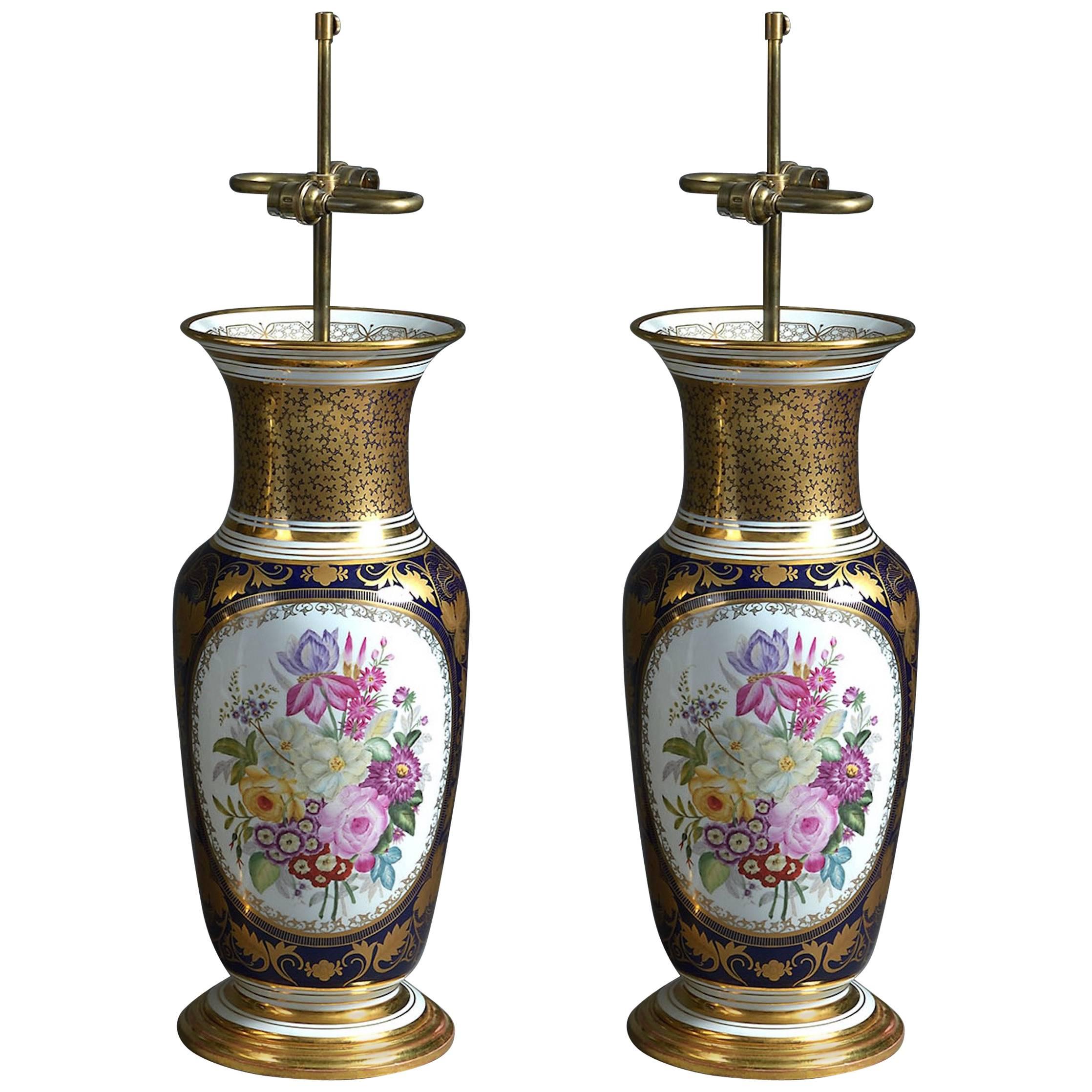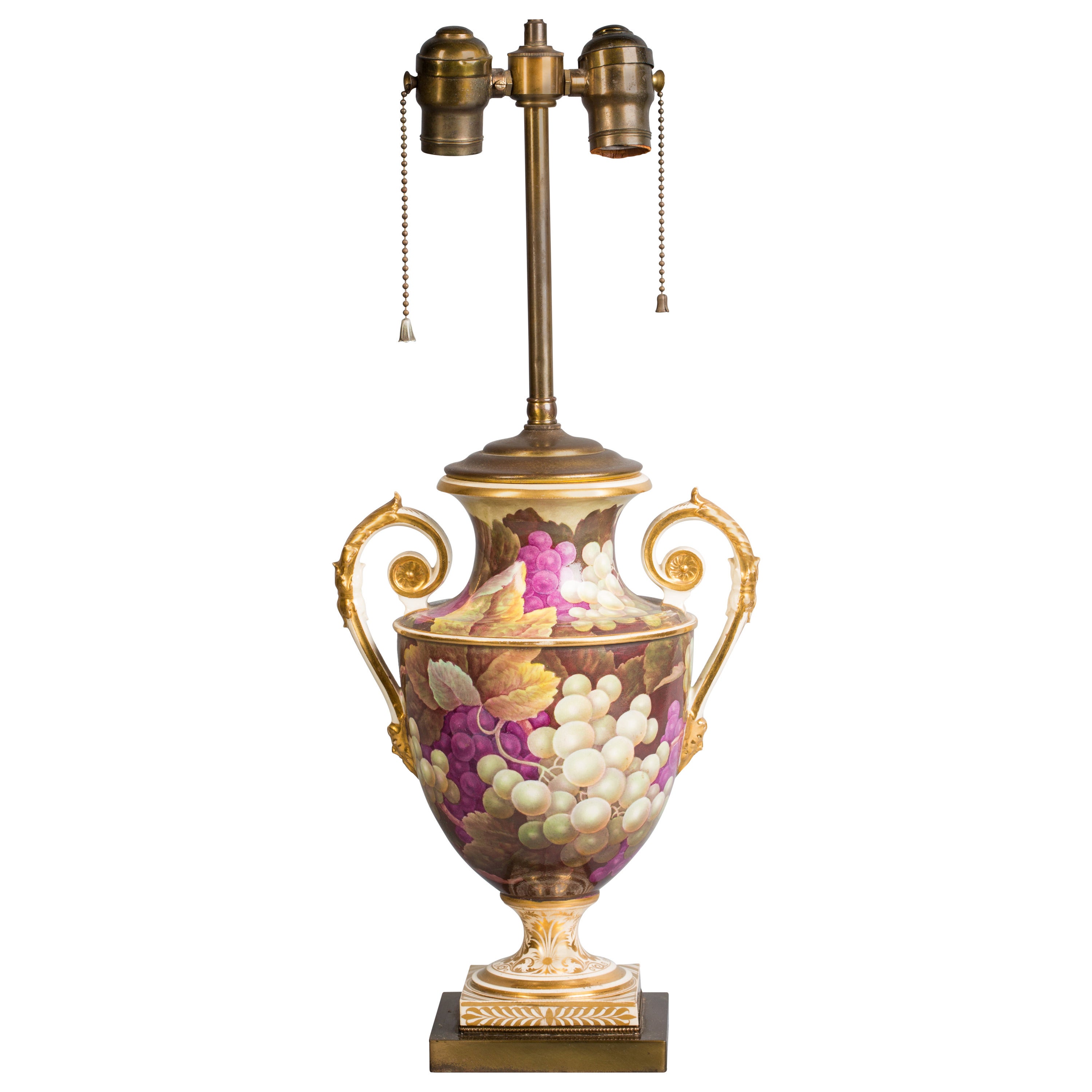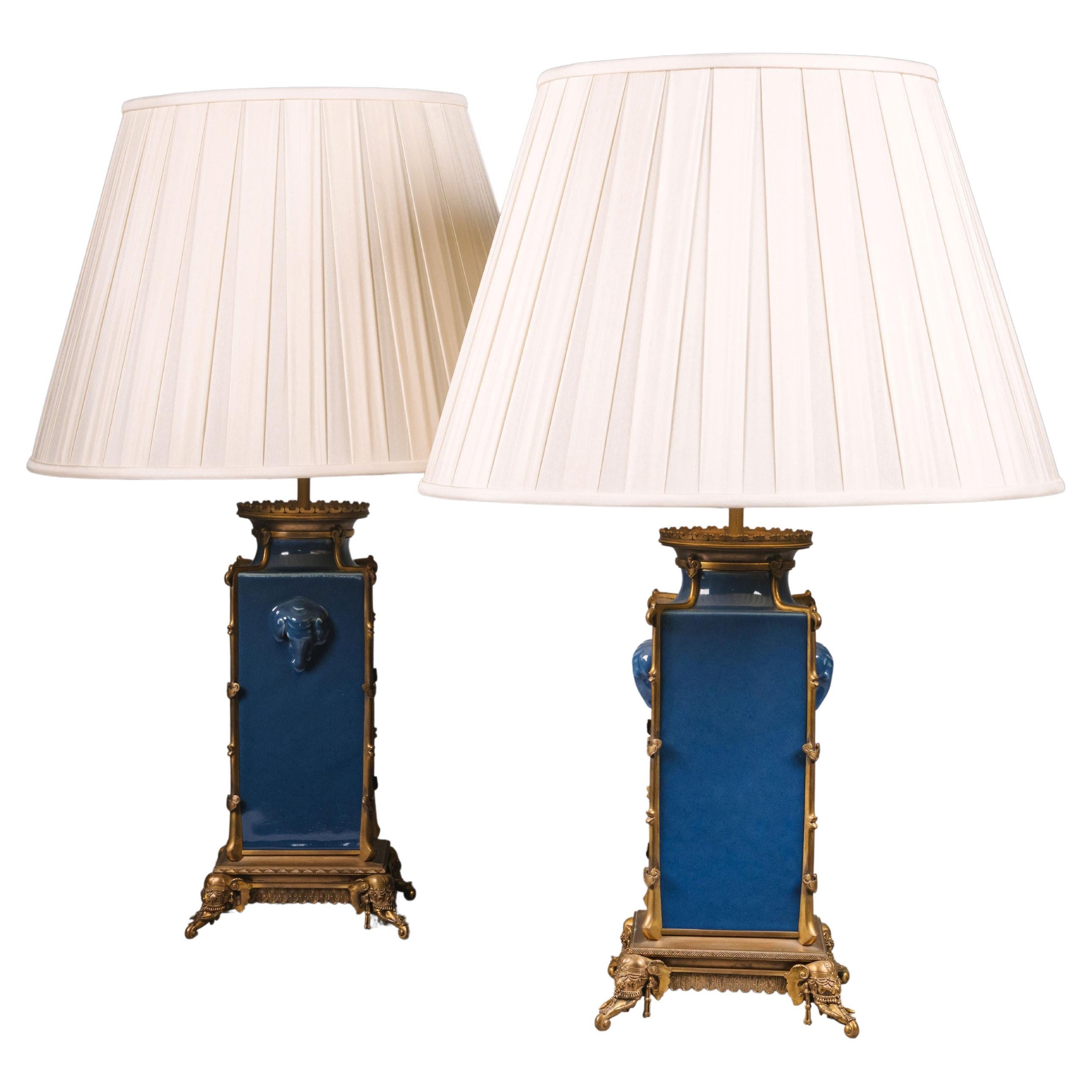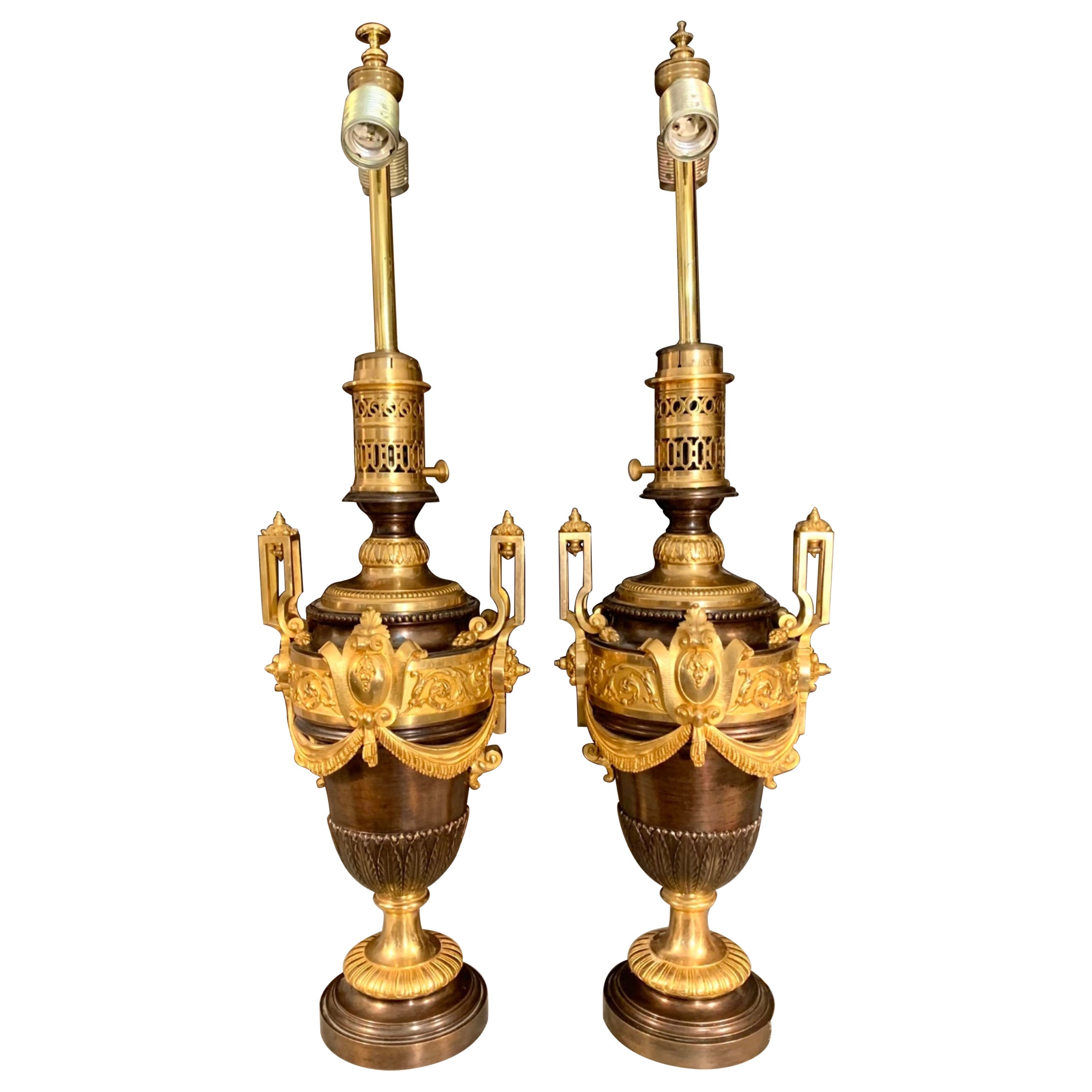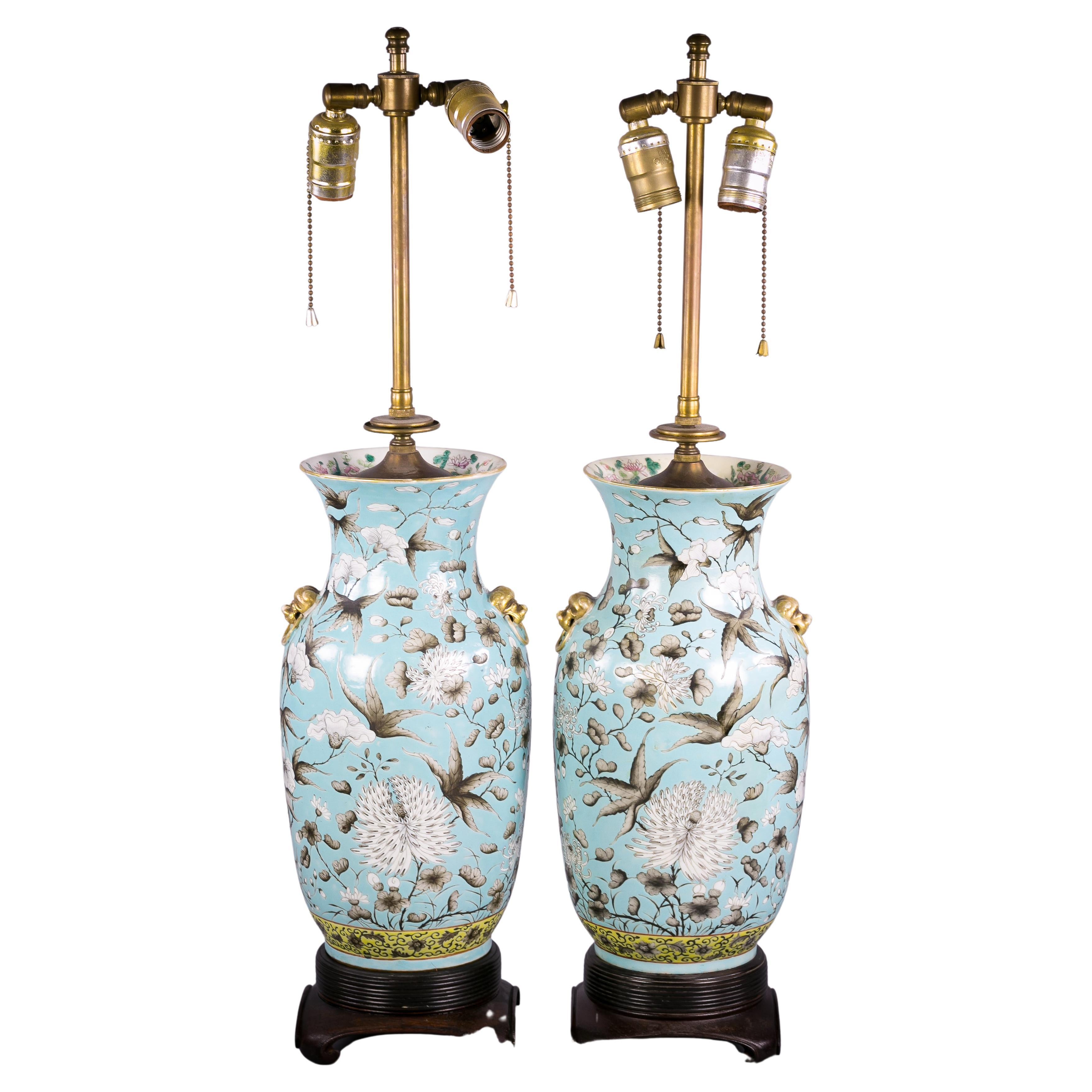Items Similar to Pair of French Ormolu-Mounted Blue-Ground Porcelain Vases Fitted as Lamps
Want more images or videos?
Request additional images or videos from the seller
1 of 5
Pair of French Ormolu-Mounted Blue-Ground Porcelain Vases Fitted as Lamps
About the Item
A fine quality pair of French Ormolu-Mounted Chinese Porcelain Vases mounted as lamps in mottled blue-ground glaze. Resting on square ormolu base with garland band and ormolu banded neck with foliage details. Blue is even brighter in person.
Origin: French
Date: 19th century
Dimension: 20 in tall, 7 in diameter
- Dimensions:Height: 20 in (50.8 cm)Diameter: 7.5 in (19.05 cm)
- Style:Chinoiserie (Of the Period)
- Materials and Techniques:
- Place of Origin:
- Period:
- Date of Manufacture:19th Century
- Condition:
- Seller Location:New York, NY
- Reference Number:
About the Seller
5.0
Vetted Seller
These experienced sellers undergo a comprehensive evaluation by our team of in-house experts.
Established in 1986
1stDibs seller since 2019
39 sales on 1stDibs
Typical response time: 8 hours
- ShippingRetrieving quote...Ships From: New York, NY
- Return PolicyA return for this item may be initiated within 2 days of delivery.
More From This SellerView All
- Pair of French Ormolu-Mounted Chinese Porcelain Vases and CoversLocated in New York, NYA fine quality pair of French Ormolu-Mounted Chinese Porcelain Vases and Covers in mottled blue-ground glaze. Resting on square ormolu base with paw feet. Origin: French Date: late ...Category
Antique 19th Century French Chinoiserie Vases
MaterialsOrmolu
- 19th Century Large Sèvres-Style Ormolu Mounted Cobalt Blue Ground Porcelain VaseLocated in New York, NYA magnificent large Sèvres-style gilt bronze mounted cobalt blue ground porcelain lidded vase. Origin: French Date: 19th century Dimension: 42 inches high.Category
Antique 19th Century French Vases
MaterialsOrmolu
- Fine Pair of Neo-Classical Revival Bronze Urns Mounted as LampsBy Ferdinand BarbedienneLocated in New York, NYOf ovoid form with classical figures cast in relief Maker: Ferdinand Barbedienne (1838-1953) Origin: French Date: late 19th century Dimension: 29 in highCategory
Antique 19th Century French Neoclassical Revival Urns
MaterialsBronze
- Ormolu-Mounted Sèvres-Style Pink-Ground VaseLocated in New York, NYVery fine quality gilt bronze mounted Sèvres-style pink-ground vase with elongated shield shape, painted with a maiden and cupids with arrows in the gar...Category
Antique 19th Century French Vases
MaterialsOrmolu
- Pair of Ormolu-Mounted Sèvres-style Porcelain Champlevé VasesLocated in New York, NYFabulous pair of fine quality bronze-mounted Sèvres-style porcelain vases on bronze base. The hand-painted depiction of cherubs and floral motifs surrounded by raised gilding. The po...Category
Antique 19th Century French Vases
MaterialsBronze
- Monumental Pair of Magnificent Ormolu Mounted Sèvres Porcelain VasesBy Bellanger, e. collotLocated in New York, NYHand painted with scenes of a chateau landscape and courtly couples in a garden, signed 'E. Collot', on a gilt and cobalt ground, gilt-bronze acanthus swag handles, base and foliate ...Category
Antique Late 19th Century French Rococo Vases
MaterialsBronze
You May Also Like
- Pair of Large Paris Porcelain Vases with Floral Panels Mounted as LampsLocated in London, GBAn exceptional pair of large scale Paris porcelain vases decorated with floral panels on one side and a stylised floral motif to the other side. Each body with gilded seaweed decorat...Category
Antique Early 19th Century French Table Lamps
MaterialsPorcelain
- Pair of Porcelain Vases Ormolu-Mounted in Lamps by Gagneau Paris XIXth CenturyBy Gagneau ParisLocated in Saint-Ouen, FRPair of large Japanese Porcelain Cone Shape Vases with Imari decoration Important mounts in ormolu and gilded metal, the base decorated with a laurel wreath, the upper part of falling leaves and a frieze of knotted ribbon. The mounts signed Gagneau, 115 R. Lafayette. Circa 1860 With their original aluminium bulb cover and original gilding Vase it self Height 47 cm The Gagneau Company is one of the most famous lighting factories in Paris in the nine-teenth century, established in 1800 at 25 rue d'Enghien in Paris and later at 115 rue de Lafayette. She has participated in many exhibitions throughout this century. She began in 1819 with the Exposition des Produits de l'Industrie and later participated in the Universal Exhibitions where she was part of the jury in the category of art bronzes (class 25) at the Universal Exhibition in Paris in 1889. "Imari" was simply the trans-shipment port for Arita wares, from where they went to the for-eign trading outposts at Nagasaki. It was the kilns at Arita which formed the heart of the Japanese porcelain industry. Arita's kilns were set up in the 17th century, after kaolin was discovered in 1616. A popular legend attributes the discovery to an immigrant Korean potter, Yi Sam-Pyeong (1579–1655), although most historians consider this doubtful. After the discovery, some kilns began to produce revised Korean-style blue and white porcelains, known as Early Imari, or "Shoki-Imari". In the mid-17th century, there were also many Chinese refugees in northern Kyushu due to the turmoil in China, and it is said that one of them brought the overglaze enamel coloring technique to Arita. Thus Shoki-Imari developed into Ko-Kutani, Imari, and later Kakiemon, which are sometimes taken as a wider group of Imari wares. Ko-Kutani was produced around 1650 for both export and domestic market.Kutani Ware is characterized by vivid green, blue, purple, yellow and red colors in bold designs of landscapes and nature. Blue and white porcelain pieces continued to be produced and they are called Ai-Kutani. Ko-Kutani Imari for the export market usually adopted Chinese design structure such as kraak style, whereas Ai-Kutani for the domestic market were highly unique in design and are ac-cordingly valued very much among collectors. Ko-Kutani style evolved into Kakiemon-style Imari, which was produced for about 50 years around 1700. Kakiemon was characterized by crisp lines, and bright blue, red and green designs of dramatically stylized floral and bird scenes. Imari achieved its technical and aes-thetic peak in the Kakiemon style, and it dominated the European market. Blue and white Kakiemon is called Ai-Kakiemon. The Kakiemon style transformed into Kinrande in the 18th century, using underglaze blue and overglaze red and gold enamels, and later additional colors. Imari began to be exported to Europe when the Chinese kilns at Jingdezhen were damaged in the political chaos and the new Qing dynasty government halted trade in 1656–1684. Ex-ports to Europe were made through the Dutch East India Company, and in Europe the des-ignation "Imari porcelain" connotes Arita wares of mostly Kinrande Imari. Export of Imari to Europe stopped in mid-18th century when China resumed export to Eu-rope, since Imari was not able to compete against Chinese products due to high labor costs. By that time, however, both Imari and Kakiemon styles were already so popular among Eu-ropeans that the Chinese export porcelain copied both, a type known as Chinese Imari. At the same time, European kilns, such as Meissen and English potteries such as Johnson Bros. and (Royal) Crown Derby, also imitated the Imari and Kakiemon styles. Export of Imari surged again in late 19th century (Meiji era) when Japonism flourished in Europe.Thus, in the western world today, two kinds of true Japanese Imari can...Category
Antique 1880s French Japonisme Table Lamps
MaterialsBronze
- English Porcelain Vase Mounted as Lamp, Derby, circa 1826Located in New York, NYEnglish porcelain vase mounted as lamp, derby, circa 1826. Attributed to artist Thomas Steele.Category
Antique 1820s English Table Lamps
MaterialsPorcelain
- Pair of 'Japonsime' Blue Porcelain Vases Mounted as LampsBy Ferdinand BarbedienneLocated in Brighton, West SussexA Pair Of 'Japonsime' Gilt-Bronze-Mounted Powder-Blue Porcelain Vases, Mounted As Lamps. By Ferdinand Barbedienne, Paris. Each with a square shaped body. The sides decorated with ...Category
Antique 19th Century French Japonisme Table Lamps
MaterialsOrmolu
- Pair French Patinated Bronze and Ormolu Vases Mounted Table LampsLocated in Madrid, ESA pair of two-handled vases / lamps in classic French Napoleon III style bronze and gilt ormolu of very good quality, each with a foliated plant decoration in bronze, the ormolu orna...Category
Antique Late 19th Century European Napoleon III Table Lamps
MaterialsBronze, Ormolu
- Pair of Chinese Turquoise Ground Porcelain Vases Mounted as Lamps, circa 1900Located in New York, NYPair of Chinese Turquoise Ground porcelain vases mounted as lamps, circa 1900 Height of vase 16.5".Category
Antique Early 1900s Chinese Table Lamps
MaterialsPorcelain
Recently Viewed
View AllMore Ways To Browse
Antique Porcelain Vase Table Lamp
Antique French Porcelain Lamps
Chinese Vase As Lamp
Chinese Vases As Lamps
Pair Porcelain Lamps France
Porcelain French Pair Lamps
Pair Of French Porcelain Lamps
Blue Garland
Bright Blue Table
Lamps Ormolu Mounted
19th French Porcelain Lamp
Porcelain Mount French Table
Blue Porcelain Lamps Pair
Ormolu Glazed
Pair Of Blue Porcelain Lamps
Gilt Table Lamps Ormolu
Pair Blue Glazed Lamps
Pair Of Glazed Blue Lamps
